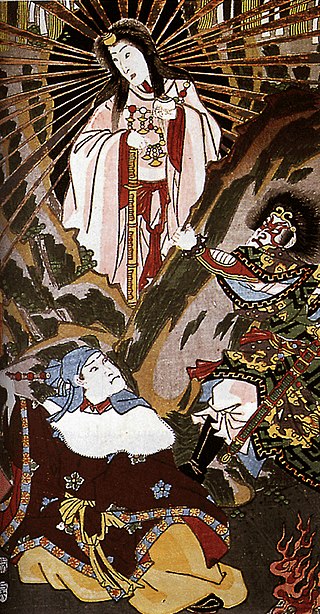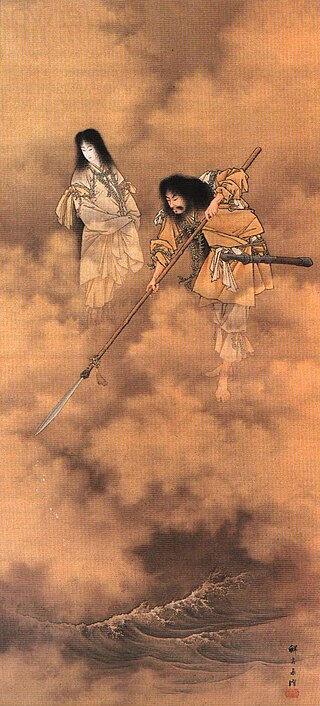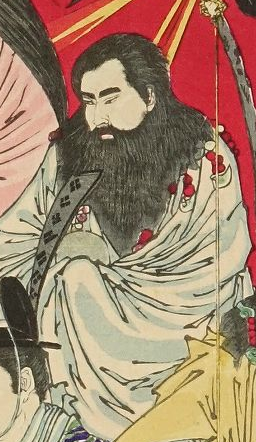Related Research Articles

Amaterasu, also known as Amaterasu Ōmikami or Ōhirume no Muchi no Kami (大日孁貴神), is the goddess of the sun in Japanese mythology. One of the major deities (kami) of Shinto, she is also portrayed in Japan's earliest literary texts, the Kojiki and the Nihon Shoki, as the ruler of the heavenly realm Takamagahara and the mythical ancestress of the Imperial House of Japan via her grandson Ninigi. Along with her siblings, the moon deity Tsukuyomi and the impetuous storm god Susanoo, she is considered to be one of the "Three Precious Children", the three most important offspring of the creator god Izanagi.
The Kojiki, also sometimes read as Furukotofumi or Furukotobumi, is an early Japanese chronicle of myths, legends, hymns, genealogies, oral traditions, and semi-historical accounts down to 641 concerning the origin of the Japanese archipelago, the kami (神), and the Japanese imperial line. It is claimed in its preface to have been composed by Ō no Yasumaro at the request of Empress Genmei in the early 8th century (711–712), and thus is usually considered to be the oldest extant literary work in Japan.

Izanagi (イザナギ/伊邪那岐/伊弉諾) or Izanaki (イザナキ), formally known as Izanagi-no-Mikoto, is the creator deity (kami) of both creation and life in Japanese mythology. He and his sister-wife Izanami are the last of the seven generations of primordial deities that manifested after the formation of heaven and earth. Izanagi and Izanami are held to be the creators of the Japanese archipelago and the progenitors of many deities, which include the sun goddess Amaterasu, the moon deity Tsukuyomi and the storm god Susanoo.

Izanami (イザナミ), formally known as Izanami-no-Mikoto, is the creator deity of both creation and death in Japanese mythology, as well as the Shinto mother goddess. She and her brother-husband Izanagi are the last of the seven generations of primordial deities that manifested after the formation of heaven and earth. Izanami and Izanagi are held to be the creators of the Japanese archipelago and the progenitors of many deities, which include the sun goddess Amaterasu, the moon deity Tsukuyomi and the storm god Susanoo.

Ninigi-no-Mikoto is a deity in Japanese mythology. Grandson of the sun goddess Amaterasu, Ninigi is regarded according to Japanese mythology as the great-grandfather of Japan’s first emperor, Emperor Jimmu. The three sacred treasures brought with Ninigi from Heaven and divine ancestry established the Japanese Imperial Family.
Kagutsuchi, also known as Hi-no-Kagutsuchi or Homusubi among other names, is the kami of fire in classical Japanese mythology.

Dōsojin is a generic name for a type of Shinto kami popularly worshipped in Kantō and neighboring areas in Japan where, as tutelary deities of borders and paths, they are believed to protect travellers, pilgrims, villages, and individuals in "transitional stages" from epidemics and evil spirits. Also called Sae no kami or Sai no kami (障の神・塞の神), Dōrokujin (道陸神) or Shakujin. Dōsojin are often represented as a human couple, carved male or female genitals, large stones or statues, or even tall poles along a road.
Ame-no-Minakanushi is a deity (kami) in Japanese mythology, portrayed in the Kojiki and the Nihon Shoki as the very first or one of the first deities who manifested when heaven and earth came into existence.
The following is a family tree of the emperors of Japan, from the legendary Emperor Jimmu to the present monarch, Naruhito.
In Japanese mythology, the Japanese creation myth is the story that describes the legendary birth of the celestial and creative world, the birth of the first gods, and the birth of the Japanese archipelago.

Amenooshihomimi (天之忍穂耳命) or Oshihomimi for short, is the first son of Amaterasu.
Ame no Hohi is a male deity and the second son of sun goddess Amaterasu in Japanese mythology. Kokusō is said to have originated from Ame no Hohi. He was also said to be the ancestor to Izumo rulers.
Takamimusubi is a god of agriculture in Japanese mythology, who was the second of the first beings to come into existence.
Kukunochi is the kami of trees, the kami is also called Ki-no-kami, or Kuku-no-shi. He is the brother of Ōyamatsumi, Shimatsuhiko, and Watatsumi.
Kamimusubi (神産巣日), also known as Kamimusuhi among other variants, is a kami and god of creation in Japanese mythology. They are a hitorigami, and the third of the first three kami to come into existence (Kotoamatsukami), alongside Ame-no-Minakanushi and Takamimusubi, forming a trio at the beginning of all creation. The name is composed of kami, denoting deity, and musubi, meaning "effecting force of creation".
Wakumusubi (和久産巣日神) is a kami of agriculture. In many versions, he was born from the urine of Izanami when she died. Another version of the Nihon Shoki states he was a child of Kagutsuchi and Haniyasu-hime.
Key
Yakusanoikazuchi or ikazuchi is a collective name for the eight kami of thunder in Japanese mythology. Each one represents a different type of storm.
Wakahirume is a goddess of the rising sun in Japanese mythology. She is the daughter or younger sister of Amaterasu. Some interpretations view her as the personification of the morning sun.
References
- ↑ Roberts, Jeremy (2009). Japanese Mythology A to Z. Infobase Publishing. p. 47. ISBN 978-1-4381-2802-3.
- ↑ Jordan, Michael (2014-05-14). Dictionary of Gods and Goddesses. Infobase Publishing. p. 111. ISBN 978-1-4381-0985-5.
- 1 2 3 Nakayama, Kaoru(中山 郁) (22 April 2005). "OLD - Encyclopedia of Shinto - Kami in Classic Texts - Haniyasu". Kokugakuin University. Archived from the original on 23 November 2020. Retrieved 24 November 2020.
- 1 2 3 Nakayama, Kaoru(中山 郁) (21 October 2021) [22 April 2005]. "Haniyasu / 國學院大學デジタルミュージアム" [NEW - Encyclopedia of Shinto - Kami in Classic Texts - Haniyasu]. Kokugakuin University. Archived from the original on 19 October 2021. Retrieved 21 October 2021.
- ↑ Ashkenazi, Michael (2003). Handbook of Japanese Mythology. ABC-CLIO. p. 297. ISBN 978-1-57607-467-1.
- ↑ Aston, W.G. (2015-11-16). "ch.VII-The Pantheon-Nature Deities page 17". Shinto - The Ancient Religion of Japan. Read Books Ltd. p. 108. ISBN 978-1-4733-7719-6.